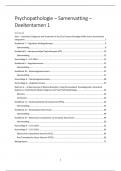Samenvatting
DEELTENTAMEN 1: College Aantekeningen en Samenvattingen - Psychopathologie () - Klinische Psychologie (ISBN: 978-90-01-88147-4)
- Vak
- Instelling
- Boek
Dit document bevat college en werkgroep aantekeningen en samenvattingen van alle relevante hoofdstukken van het Klinische Psychologie boek van Simon et al. voor deeltentamen 1.
[Meer zien]





